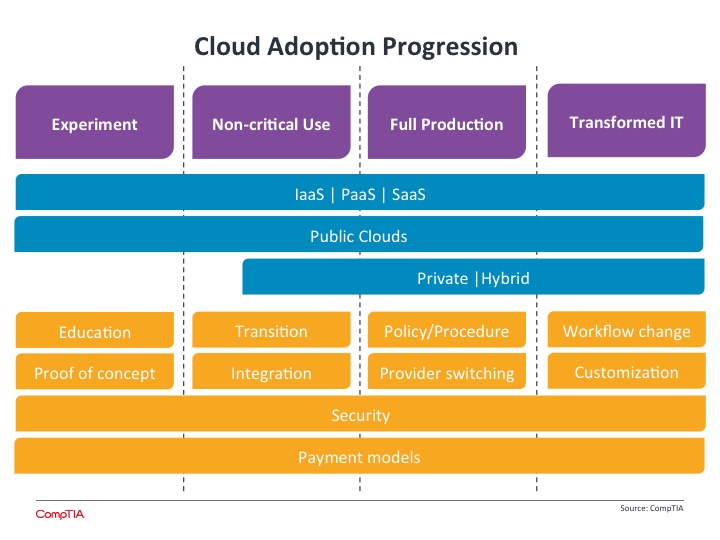Cloud computing has been a somewhat divisive topic in the IT industry over the past five years. In the early days, it was hard getting everyone to agree on a definition, and more recently, cloud computing’s been dismissed as a marketing term. At a minimum, the concept has created a lively dialogue. More likely, it is starting to truly transform business operations, and findings from CompTIA’s 5th Annual Trends in Cloud Computing study point in this direction.
The new study, available here, examines cloud computing among two groups: those using cloud for their own business operations — let’s call them end-users — and channel firms including cloud offerings in their portfolios. In both segments, some cloud confusion remains. By definition, all cloud users should be utilizing either public cloud providers or private cloud resources (or both). However, 28 percent of cloud end users in the study didn’t select either option, leaving some question as to how familiar they really are with their cloud architecture. On the channel side, nearly every firm says they have cloud offerings, but the top challenge in moving forward is selecting the best business model, a foundational step.
As companies start building IT systems that use all available options to help drive business, the confusion over cloud usage will fade. End-users are making good progress with cloud adoption, as 69 percent identify as being in one of the middle two stages defined in CompTIA’s progression model. This means that businesses are exploring technical issues, like migration and integration, as well as operational issues, like policies and workflow.
Moving from stage to stage, companies will encounter a variety of different challenges. As companies decide how to begin their cloud initiatives, the early challenges revolve around education and calculating ROI. Once they begin placing applications in cloud systems, companies will likely grow more concerned about integration and vendor lock-in, especially as they begin dealing with the realities of a multi-cloud environment. Finally, the challenges become more cultural and behavioral as firms try to transform their workflow to best utilize cloud systems. These challenges appear to be the steepest and indicate the areas where businesses might benefit most from outside help.
Predicted Areas of Change
As end-users move with increasing frequency toward cloud-enabled operations, there are three main areas where changes take place:
- Policies and procedures. Companies will have to define how they expect to function, especially in the area of procurement where lines of business may be getting more active.
- Internal IT department changes. Most often, this involves hiring additional skills or retraining to build up cloud-related expertise.
- Use of third parties. The number of end-users contracting with outside firms for cloud grew from 11 percent in 2013 to 17 percent in 2014 — a positive trend, but one that indicates plenty of room for growth.
With five years of cloud history in the books, attention is turning to the next phase. Such a large structural change typically drives operations for 25 to 30 years, so the next two decades should see continued innovation and optimization of cloud usage models. It’s not worth debating over definitions anymore; it’s time to forge ahead and discover the new IT ecosystem that is being created.
Seth Robinson is CompTIA’s senior director of technology analysis.


